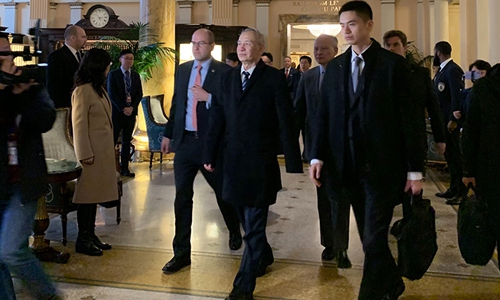HOME >> OPINION
Phase one deal serves as roadmap for China-US ties
Source:Global Times Published: 2020/1/14 22:03:42

Chinese Vice Premier Liu He arrives at his hotel Monday afternoon in Washington. He is expected to conclude a phase one trade agreement with the US. Photo:CGTN
Vice premier Liu He led a delegation to the US on Monday, Beijing time, where the two countries will sign the phase one trade deal, adding something new to interpret as the bilateral ties have been strained across the board for the last two years.
This is the first deal to be signed during the decline of China-US relations. It is interesting that it is not an arms control agreement as the US and USSR signed during the Cold War. If phase one trade deal can be implemented and China and the US can reach a comprehensive economic and trade agreement on this basis, then the difference between the first half of the 21st century and the second half of the 20th century will be clearer.
The US usually divides the major powers into allies, partners, and strategic competitors. Now it includes both China and Russia in the last category.
However, China is also the largest trading partner of the US, and it is very important that the phase one trade deal will further expand the trade volume between the two countries and enhance the level of economic cooperation between the two countries.
The phase one deal is not the whole of China-US relations, and it is hard to say that it is the key hub of current China-US relations. Looking around, Xinjiang, Tibet, Hong Kong, and Taiwan, etc., have long been sore spots in China-US relations, or have opened new wounds. In addition, both militaries are consolidating their combat readiness, either openly or quietly regarding each other as imaginary enemies. Not only the Taiwan Strait, but also the South China Sea is becoming increasingly sensitive to each other. The two countries are almost at loggerheads in public opinion.
Each point of friction serves as a roadmap for China-US relations. Now the phase one deal has also set up a roadmap for the competition that will guide the China-US relations.
We believe that the China-US relationship in the 21st century will not only be a planned one, but one that results from actual steps. It is conceivable that China-US relations will go forward in many directions in the future.
What is certain now is that China and the US are very much on guard against each other, and the mutual strategic suspicion between the two countries has produced a domino effect. The phase one deal contradicts to such a trend. So many people worry that it is fragile, and this worry obviously makes sense.
At the same time, it is worth noting that the phase one deal between China and the US shows that both sides share a common value orientation, that is, it is more important for both sides to expand their own interests than to hurt each other's interests. The two countries have not yet reached the point where they are truly incompatible.
If China and the US move forward along such value direction, there is realistic hope that the relationship will not be misguided to a more serious loss of control. Because China is a large and developing market, there is ample room for our new and shared interests, and our ability to shape the future of China-US relations will grow. Of course, while making active efforts in China-US relations, China will not weaken its resilience to the new destruction of economic and trade relations between the two countries.
In the past, there was indeed some trade imbalance between China and the US. However, the increase in the purchase of American products not only meets the needs of the Chinese people for upgrading their consumption, but will also strengthen the ties of cooperation between China and the US and keep the China-US relationship in the direction it should be in the 21st century. This is indeed in the interest of the Chinese people, and the people of the US and the world.
Posted in: VIEWPOINT